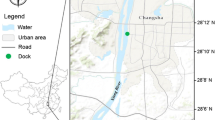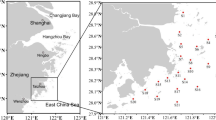Abstract
The concentrations of lead, chromium, cadmium, arsenic, and mercury were analyzed in the muscle and liver (hepatopancreas) of three fish species (Silurus asotus, Cyprinus carpio, and Carassius auratus auratus) from the Jinsha and Tuo Rivers. The above mentioned metal concentrations in the muscles of the three fish species were below the permissible limits, indicating that these fishes are safe for human consumption. The concentration of mercury in the carnivorous fishes was higher than that in the omnivorous fishes. There was no significant difference in growth rate and the concentration of lead, chromium, cadmium, arsenic, and mercury among the fishes from Panzhihua and Fushun. In the two age groups, the concentration of mercury did not vary significantly with growth rate of fish. The relationship between heavy metal concentration and growth rate of fish varied with metal species, fish species, and fish tissue.


Similar content being viewed by others
References
Al-Yousuf MH, El-Shahawi MS, Al-Ghais SM (2000) Trace metals in liver, skin and muscle of Lethrinus lentjan fish species in relation to body length and sex. Sci Total Environ 256:87–94
Burger J, Gaines KF, Boring CS, Warren L Jr, Snodgrass S, Gochfeld J M (2001) Mercury and selenium in fish from the Savannah River: species, trophic level and locational differences. Environ Res 87:108–118
Canli M, Atli G (2003) The relationships between heavy metal (Cd, Cr, Cu, Fe, Pb, Zn) levels and the size of six Mediterranean fish species. Environ Pollut 121:129–136
Chinese Food Health Criterion (2012) Maximum levels of contaminants in foods. GB 2762–2012. Ministry of Health of People’s Republic of China, Beijing
Chinese Food Health Criterion (2014a) The determination of total arsenic and inorganic arsenic in foods. GB5009.11-2014. National Health and Family Planning Commission of the People’s Republic of China
Chinese Food Health Criterion (2014b) The determination of chromium in foods. GB5009.123-2014. National Health and Family Planning Commission of the People’s Republic of China
Dalla Riva S, Abelmoschi ML, Magi E, Soggia F (2004) The utilization of the Antarctic environmental specimen bank (BCAA) in monitoring Cd and Hg in an antarctic coastal area in Terra Nova Bay (Ross Sea—Northern Victoria Land). Chemosphere 56:59–69
Dallinger R, Kautzky H (1985) The importance of contaminated food and uptake of heavy metals by rainbow trout (Salmo gairdneri): a field study. Oecologia 67:82–89
Dallinger R, Prosi F, Segner H, Back H (1987) Contaminated food uptake of heavy metals by fish: a review and proposal for further research. Oecologia 73:91–98
Ding RH (1989) Fish stocks and fisheries issues of Tuo River. J Resour Dev Prot 5(3):13–19
Ding RH (1994) The fishes of Sichuan, China. Sichuan Publishing House of Science and Technology, Chengdu
European Commission (2006) Commission Regulation (EC) No1881/2006 of 19 December 2006. Setting maximum levels for certain contaminants in foodstuffs. 20.12.2006. Off J Eur Union L 364:5–24
Farkas A, Salánki J, Baranka I (2000) Heavy metal concentrations in fish of Lake Balaton. Lakes Reserv: Res Manag 5:271–279
Farkas A, Salánki J, Specziar A (2002) Relation between growth and the heavy metal concentration in organs of bream Abramis brama L. populating Lake Balaton. Arch Environ Contam Toxicol 43:236–243
Farkas A, Salanki J, Specziar A (2003) Age- and size- specific patterns of heavy metals in the organs of freshwater fish Abramis brama L populating a low-contaminated site. Water Res 37(5):959–964
Gao SB, Tang HY, Qian Y, Yang Z, Chen JS (2013) Status of fishery resources in the mainstream of the lower reaches of Jinsha River. J Hydroecol 34(1):44–49
Huang Q, Zhang Y, Liu S, Wang W, Luo Y (2013) Intraspecific scaling of the resting and maximum metabolic rates of the Crucian Carp (Carassius auratus). PLoS ONE 8(12):e82837. https://doi.org/10.1371/journal.pone.0082837
Kraal MH, Kraak MH, de Groot CJ, Davids C (1995) Uptake and tissue distribution of dietary and aqueous cadmium by carp (Cyprinus carpio). Ecotoxicol Environ Saf 31(2):179–183
Li J (2016) The contents of five heavy metals in fifteen common fish species from upstream of the Yangtze River and ecotoxicological effects of the waterborne cadmium on Silurus meridionalis. Dissertation, Southwest University Chongqing, China
Li J, Xie XJ (2016) Heavy metal concentrations in fish species from three gorges reservoir, China, after impoundment. Bull Environ Contam Toxicol 96(5):616–621
Łuszczek-Trojnar E, Drąg-Kozak E, Popek W (2013) Lead accumulation and elimination in tissues of Prussian carp, Carassius gibelio (Bloch, 1782), after long-term dietary exposure, and depuration periods. Environ Sci Pollut Res Int 20(5):3122–3132
Mashroofeh A, Bakhtiari AR, Pourkazemi M, Rasoul S (2013) Bioaccumulation of Cd, Pb and Zn in the edible and inedible tissues of three sturgeon species in the Iranian coastline of the Caspian Sea. Chemosphere 90:573–580
Merciai R, Guasch H, Kumar A, Sabater S, Garcia-Berthou E (2014) Trace metal concentration and fish size: variation among fish species in a Mediterranean river. Ecotoxicol Environ Saf 107:154–161
Noël L, Chekri R, Millour S, Merlo M, Leblanc JC, Guérin T (2013) Distribution and relationships of As, Cd, Pb and Hg in freshwater fish from five French fishing areas. Chemosphere 90:1900–1910
Rajkowska M, Protasowicki M (2013) Distribution of metals (Fe, Mn, Zn, Cu) in fish tissues in two lakes of different trophy in Northwestern Poland. Environ Monit Assess 185:3493–3502
Squadrone S, Prearo M, Brizio P, Gavinelli S, Pellegrino M, Scanzio T, Guarise S, Benedetto A, Abete MC(2013) Heavy metals distribution in muscle, liver, kidney and gill of European catfish (Silurus glanis) from Italian Rivers. Chemosphere 90:358–365
Storelli MM, Marcotrigiano GO (2000) Fish for human consumption: risk of contamination by mercury. Food Addit Contam 17:1007–1011
Tabatabaie T, Ghomi MR, Amiri F, Zamani-ahmadmahmoodi R (2011) Comparative study of mercury accumulation in two fish species, (Cyprinus carpio and Sander lucioperca) from Anzali and Gomishan Wetlands in the Southern Coast of the Caspian Sea. Bull Environ Contam Toxicol 87:674–677
Wei Y, Zhang J, Zhang D, Tu T, Luo L (2014) Metal concentrations in various fish organs of different fish species from Poyang Lake, China. Ecotoxicol Environ Saf 104:182–188
Xu ZQ, Ni SJ, Zhang CJ, Tuo XG, Teng YG (2004) The distribution charactristics and evaluation of heavy metals of Jiansha River sediments in Panzhihua. Comput Tech Geophys Geochem Explor 26(3):252–255
Yi YJ, Zhang SH (2012) Heavy metal (Cd, Cr, Cu, Hg, Pb, Zn) concentrations in seven fish species in relation to fish size and location along the Yangtze River. Environ Sci Pollut Res 19(9):3989–3996
Yilmaz F, Özdemir N, Demirak A, Tuna AL (2007) Heavy metal levels in two fish species Leuciscus cephalus and Lepomis gibbosus. Food Chem 100(2):830–835
Zhao WH, Gao Y (2011) Analysis on annual and decadal runoff variation characteristics of Jinsha River Basin. Yangtze River 42(6):98–100
Zhu J, Chen SL, Li YT, Zhao YF, Fu X (2013) Research on runoff variation of the upper basin of the Three Gorges Reservoir. China Rural Water Hydropower 3:10–13
Acknowledgements
This work was supported by the Natural Science Foundation of Chongqing (No. cstc2013jjB80008), the Fundamental Research Funds for the Central Universities (No. XDJK2016C156), the Start-up Research Grant from Qinzhou University (No. 2017KYQD107), and the Research Funds Guangxi Key Laboratory of Beibu Gulf Marine Biodiversity Conservation (No. 2018ZB03).
Author information
Authors and Affiliations
Corresponding authors
Rights and permissions
About this article
Cite this article
Li, J., Yan, Y., Yue, N. et al. Comparative Study of Metal Accumulation in Three Fish Species (Silurus asotus, Cyprinus carpio, and Carassius auratus auratus) from the Jinsha and Tuo Rivers Located Upstream of the Yangtze River, China. Bull Environ Contam Toxicol 101, 26–32 (2018). https://doi.org/10.1007/s00128-018-2375-8
Received:
Accepted:
Published:
Issue Date:
DOI: https://doi.org/10.1007/s00128-018-2375-8




